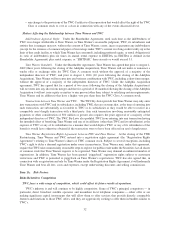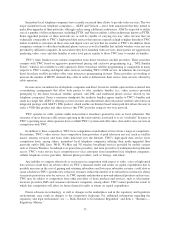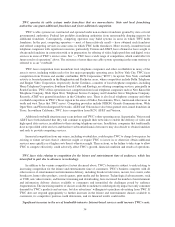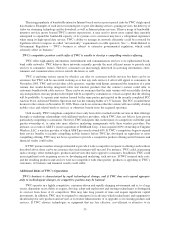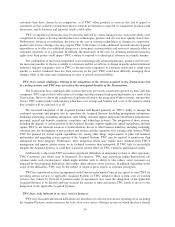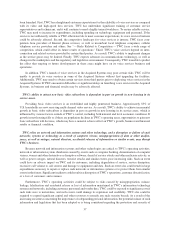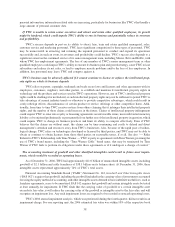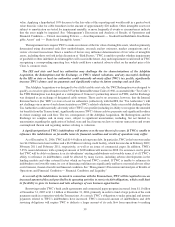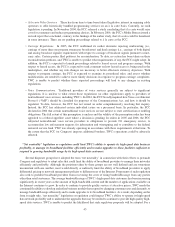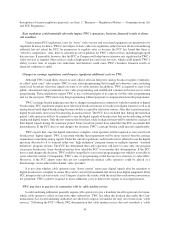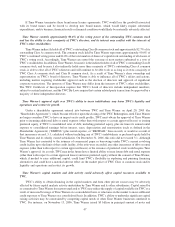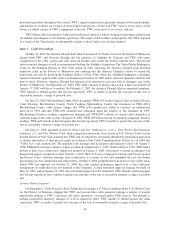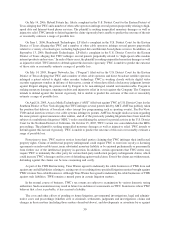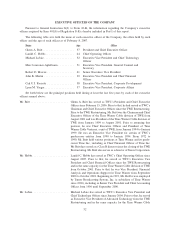Time Warner Cable 2006 Annual Report Download - page 47
Download and view the complete annual report
Please find page 47 of the 2006 Time Warner Cable annual report below. You can navigate through the pages in the report by either clicking on the pages listed below, or by using the keyword search tool below to find specific information within the annual report.ready” and “digital cable ready” televisions and other devices, as well as the IT industry’s provision of computing
devices capable of tuning, storing and displaying cable video signals, means customers owning these devices may
use a different user interface from the one TWC provides and/or may not be able to access services requiring two-
way transmission capabilities unless they also have a set-top box. Accordingly, customers using these devices
without set-top boxes may have limited exposure and access to TWC’s advanced video services, including its
interactive program guide and VOD and SVOD. If such devices attain wide consumer acceptance, TWC’s revenue
from equipment rental and two-way transmission-based services could decrease, and there could be a negative
impact on TWC’s ability to sell advanced services to customers. TWC cannot predict the extent to which different
interfaces will affect TWC’s future business and operations. See Item 1, “Business — Regulatory Matters —
Communications Act and FCC Regulation.”
TWC and other cable operators are involved in various efforts to ensure that consumer electronics and IT
industry devices are capable of utilizing TWC’s two-way services, including: direct arrangements with a handful of
consumer electronics companies that have led to the imminent deployment of a limited number of two-way capable
televisions and other devices; continuing efforts (unsuccessful to date) to negotiate two-way interoperability
standards with the broad consumer electronics industry; the development of an open software architecture layer that
such devices could use to accept two-way applications; and an effort to develop a downloadable security system for
consumer electronics devices. No assurances can be given that these or other efforts will be successful or that, if
successful, consumers will widely adopt devices utilizing these technologies.
Risks Related to Government Regulation
TWC’s business is subject to extensive governmental regulation, which could adversely affect TWC’s business.
TWC’s video and voice services are subject to extensive regulation at the federal, state, and local levels. In
addition, the federal government also has been exploring possible regulation of high-speed data services. Additional
regulation, including regulation relating to rates, equipment, programming, levels and types of services, taxes and
other charges, could have an adverse impact on TWC’s services. TWC expects that legislative enactments, court
actions, and regulatory proceedings will continue to clarify and in some cases change the rights of cable companies
and other entities providing video, data and voice services under the Communications Act and other laws, possibly
in ways that TWC has not foreseen. The results of these legislative, judicial, and administrative actions may
materially affect TWC’s business operations in areas such as:
•Cable Franchising. At the federal level, various provisions have been introduced in connection with
broader Communications Act reform that would streamline the video franchising process to facilitate entry
by new competitors. To date, no such measures have been adopted by Congress. In December 2006, the FCC
adopted an order in which the agency concluded that the current franchise approval process constitutes an
unreasonable barrier to entry that impedes the development of cable competition and broadband deploy-
ment. As a result, the agency adopted new rules intended to limit the ability of county- and municipal-level
franchising authorities to delay or refuse the grant of competitive franchises. Among other things, the new
rules: establish deadlines for franchising authorities to act on applications; prohibit franchising authorities
from placing unreasonable build-out demands on applicants; specify that certain fees, costs, and other
compensation to franchising authorities will count towards the statutory five-percent cap on franchise fees;
prohibit franchising authorities from requiring applicants to undertake certain obligations concerning the
provision of public, educational, and governmental access programming and institutional networks; and
preempt local level-playing-field regulations, and similar provisions, to the extent they impose restrictions
on applicants greater than those in the FCC’s new rules.
At the state level, several states, including California, New Jersey, North Carolina, South Carolina and Texas
have enacted statutes intended to streamline entry by additional video competitors. Some of these statutes
provide more favorable treatment to new entrants than to existing providers. Similar bills are pending or may
be enacted in additional states. To the extent federal or state laws or regulations facilitate additional
competitive entry or create more favorable regulatory treatment for new entrants, TWC’s operations could
be materially and adversely affected.
42


